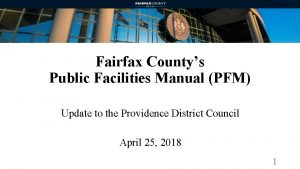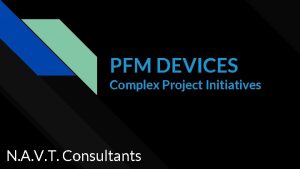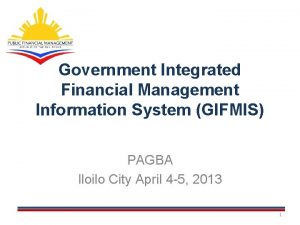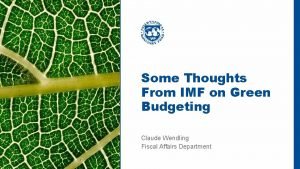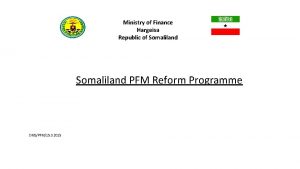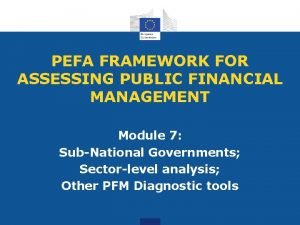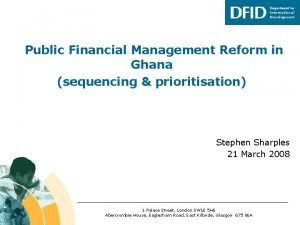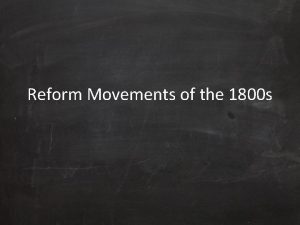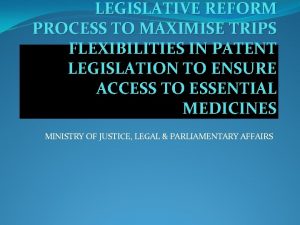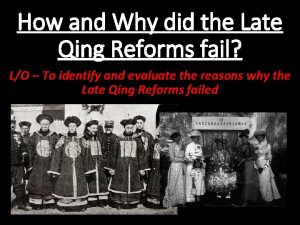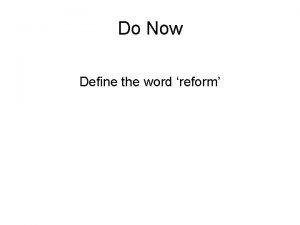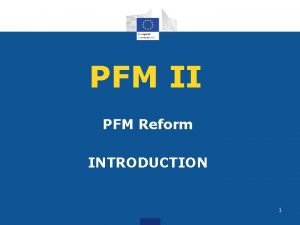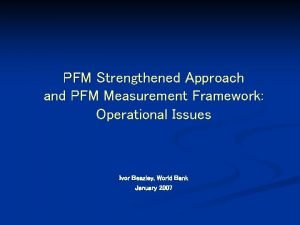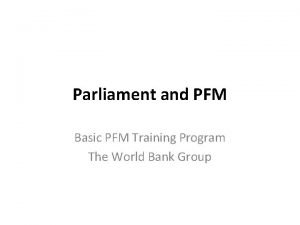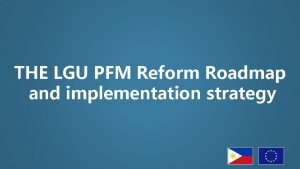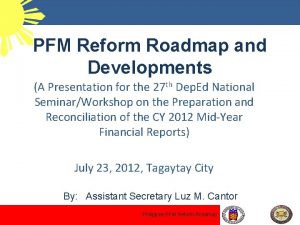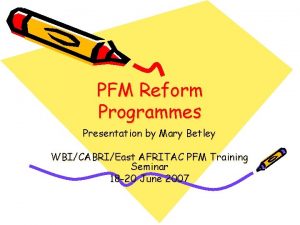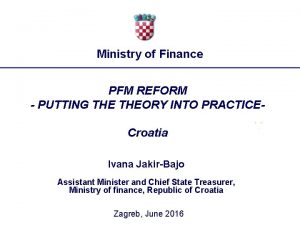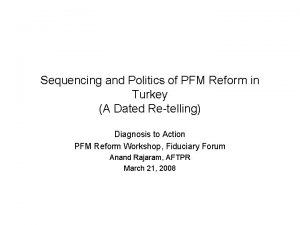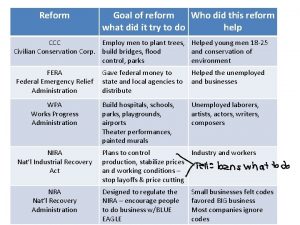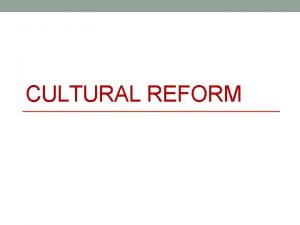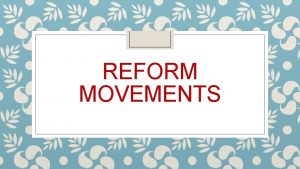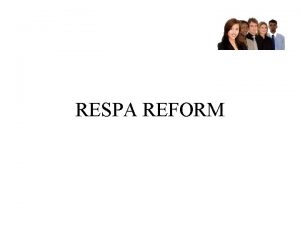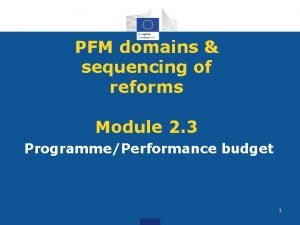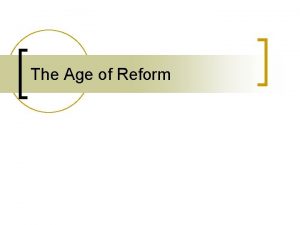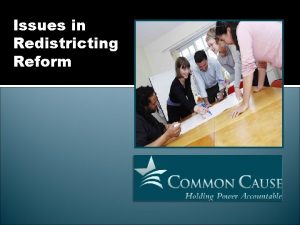Approaches to PFM reform Module 1 2 Why


























- Slides: 26

Approaches to PFM reform Module 1. 2 Why reform PFM systems? Why establish a sequence? 1

Day 1: Approaches to PFM reform • Module 1. 1. PFM objectives and budgetary approaches • Module 1. 2. Why reform PFM systems? Why establish a sequence? • Module 1. 3. The starting point: assessing PFM systems • Module 1. 4. Conditions for successful reform 2

Module 1. 2. Objectives of the module After a brief presentation of the objectives of reform, this module introduces basic notions (or essential functions) of a budgetary system & examines issues related to “sequencing” (determining the different steps) of budgetary reform 3

Module 1. 2. Outline • Why reform? • Why establish sequence? • The foundations (or essential functions) of PFM • The platform approach 4 • How to address reforms that are too complex in the context of a given country

Why reform a budgetary system? • Reforms of PFM system aim at improving performance: i. e. Strengthen at each stage of the PFM cycle • Improving performance of a PFM system generally requires to combine three different approaches: (i) strengthen, (ii) improve, (iii) reform • Relative importance of each approach depends on the country context 5

• Strengthen existing system Combine: • • Training (i) strengthen; • Introduce tools (ii) improve; • Improve (iii) reform 6 • Manuals, systems & processes • Training • Reform • Reshape laws, regulations, processes • Change institutional arrangements • Create structures to manage 6 reforms

Module 1. 2. Outline • Why reform? • Why establish sequence? • The foundations (or essential functions) of PFM • The platform approach • How to process reforms that are too complex for the context of a given country 7

Why establish a sequence of reforms? (1) • In developed countries, experience demonstrates that budgetary reform takes a long time • Over 5 years for an accounting reform in UK • In France: LOLF – prepared in 1999; voted in 2001; Implemented in 2006 Budget • Experience shows that premature introduction of complex instruments in developing/transition countries is counterproductive 8

Why establish a sequence of reforms? (2) • A budgetary system is shaped by a number of factors, both political & cultural - changing these to reshape the system takes time. • Reform is a continuous & permanent process: crucial to go through the process of learning by experience (There is no magic formula!) Correct errors, Adapt to changes Step by step improvement 9

Module 1. 2. Outline • Why reform? • Why establish a sequencing? • The foundations (or essential functions) of PFM • The platform approach • How to process reforms that are too complex for the context of a given country 10

Allen Schick: the foundations first! • In 1998, Schick decides to react against the attempts to export the New Zealand model & apply it to developing countries. • He recommends to first consolidate ‘foundations’, rather than “leapfrogging”: often referred to as “core functions” (Basic first) Schick, Allen. 1998. “Why Most Developing Countries Should Not Try New. Zealand Reforms. ” The World Bank Research Observer 11

Schick recommends a sound base, to: • create environment that enables & demands performance before introducing results-based budgetary systems • control cash before products • account for disbursements before accruals • introduce external control over sector ministries before internal control, only then give responsibility to managers • have sound accounting system before establishing IFMIS • define work to be done before defining expected results • ensure implementation of private sector contracts before introducing performance contracts in public sector • introduce performance audit only if financial audit effective • adopt and execute reliable & predictable budgets before asking managers to manage resources effectively 12

Guidance for development of internal supervision Following same thought, Schick identifies 3 stages to the development of control systems: 1. supervision by third party external to spending ministries (i. e. Mo. F) 2. internal supervision within spending ministries 3. Strengthen managerial accountability Schick considers following these 3 stages necessary to develop a budgetary culture: nevertheless, third party supervision (1 st stage) must be fair & realistic in order to constitute a solid foundation 13

What are the objectives and dimensions of the foundations? Aggregate fiscal discipline Be accountable towards citizens, be receptive Role of Parliament in democratic societies Resource allocation & fiscal policy consistent with objectives Proper procedures (integrity, regularity) 14 Efficient public service provision and tax administration ?

How to define ‘foundations’? Also called “core functions’’. Definitions linked to hierarchy amongst PFM objectives in module 1. 1 Suggested definitions: • Set of functions necessary to ensure that other functions are sustainably applicable, at limited cost • Functions aimed at ensuring budgetary discipline (integrity, regularity – financial compliance) • Taking in account, at least in the 2 nd stage, of ‘‘budget credibility’’ under PEFA (i. e. Budget executed according to initial provisions) • Budget credibility requires a level of aggregate fiscal discipline (consideration for macroeconomic stability) 15

Examples of basic functions • Administrative as well as economic classification of expenses (consistent with GFS) • Satisfactory level of comprehensiveness of budget • Taxpayer registration • Regular monitoring of financial budget – cash & commitments • Registry of physical assets for “risky” assets (e. g. Vehicles, computers) • End-of-year accounts • Budget Review for the n-1 Budget transmitted to Parliament at latest at same time as n+1 year Budget 16

‘‘Foundations first’’: Should we have reservations concerning this approach? • Rarely start from scratch: • “Advanced” reforms may be implemented, even if not all core functions have been(!) • Systems have strengths & weaknesses: always have to have 100% of ‘foundations’? • Reforms must be attractive from beginning • Central control is not panacea • Risks of hyper-centralisation, & corruption of supervisors: Schick highlights loyalty of centre • Sectoral ministries must be involved in the reforms: cannot only be controlled 17

Module 1. 2. Outline • Why reform? • Why establish a sequencing? • The foundations (or essential functions) of PFM • The platform approach • How to process reforms that are too complex for the context of a given country 18

The ‘platform approach’ • The platform: a coherent set of measures that achieve a set of realistic improvements in public finance management • The platform strategy is composed of a sequence of different platforms • Each platform sets the ground for the next one Cf. Peter Brooke. Rapport pour PEFA et DFID briefing paper 2005 19

Example: Cambodia 20

Shortcomings of the platform approach Implemented in Cambodia, Kenya, …Too early to judge (? ), but can sometimes be very complex: According to Allen • Insufficient emphasis on institutional constraints, underestimation of resistances • Activity overload. In Cambodia: platform comprised 27 activities, 250 specific actions • Unrealistic time horizon, mediocre prioritization • Micro-management 21

Platform approach: avoid being schematic, keep it simple • As platforms follow each other, some will inevitably overlap • existing system must be taken into account, as it may be more “advanced” • previous “platforms” must be strengthened • First platform (foundations+? ) can be defined, & probably second: but can we really go any further? ? 22

Module 1. 2. Outline • Why reform? • Why establish a sequencing? • The foundations (or essential functions) of PFM • The platform approach • How to process reforms that are too complex for the context of a given country 23

The dilemma • Many developing countries implement complex reforms, whereas their foundations (or “core functions”) are only partially implemented (c. f. module 1. 4): e. g. MTEF, programme budget, accrual accounting, etc. • Implementing such reforms goes against logical order, but it may be driven by: • Pressure from donors • Internal determination to show that country is on the path of modernisation & capable to carry out complex reforms, etc. 24

How to handle such situations? Strengthening foundations must be priority: however, if not possible to avoid complex reforms, is necessary to: • Ensure that basic measures & necessary preconditions for the complex reform are included in reform programme • Cf. priorities defined by domains of PFM (Cf day 2 modules - e. g. : introducing assets registers if country wishes to develop accrual accounting) • Reshape complex reform measures & limit their ambition 25 • E. g. , a programme budget may initially be limited to an information document

Key message • A budgetary reform encompasses a series of distinct stages. During first stage of reform, utmost attention should be paid to the foundations of budgetary system, i. e. functions that ensure budgetary discipline. 26
 Hey hey bye bye
Hey hey bye bye Ap psychology module 2 review
Ap psychology module 2 review Fairfax pfm
Fairfax pfm Pfm devices
Pfm devices Gifmis modules
Gifmis modules Pfm roofing
Pfm roofing Pfm somaliland
Pfm somaliland Pfm asset management
Pfm asset management Pfm somaliland learning
Pfm somaliland learning Diagnostic tools for pfm
Diagnostic tools for pfm Pfm system
Pfm system Don't ask why why why
Don't ask why why why C device module module 1
C device module module 1 The pearl vocabulary chapter 3
The pearl vocabulary chapter 3 The spirit of reform lesson 1
The spirit of reform lesson 1 Was the tva a relief recovery reform
Was the tva a relief recovery reform Chapter 8 section 1 religion sparks reform
Chapter 8 section 1 religion sparks reform When was the education reform movement
When was the education reform movement Reform movements 1800s
Reform movements 1800s Kalvenizm nedir
Kalvenizm nedir Law reform process
Law reform process Land reform definition
Land reform definition Societal def
Societal def Late qing reform
Late qing reform Was the tva a relief recovery reform
Was the tva a relief recovery reform Rural settlement grade 12 geography
Rural settlement grade 12 geography Define the word reform
Define the word reform


